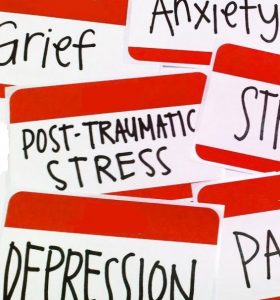
According to World Health Organization (WHO), “Mental health is a state of well-being in which an individual realizes his or her own abilities, can cope with the normal stresses of life, can work productively, and is able to make a contribution to his or her community.”
The United Nations, for statistical purposes, defines ‘youth’, as those “persons between the ages of 15 and 24 years, without prejudice to other definitions by Member States”. By that definition, therefore, children are those persons under the age of 14.’’
Mental health disorders account for the highest burden of disease among young people worldwide. More than 50% of mental health disorders can be diagnosed before the age of 25, making childhood and youth years a critical time for mental health promotion. Early identification and access to effective treatment is very important.
Having a mental health disorder at a young age is different from having one as an adult. When a developing child or youth is afflicted with a mental health disorder, it becomes difficult for them to acquire the necessary skills and habits that they should, at that time in their lives. Prevention of a disorder at a young age may significantly decrease the chances that a child will suffer from a disorder later in life. Promoting healthy behaviours and taking steps to better protect young people from health risks are critical for the prevention of health problems in adulthood.
Therefore, it is strongly advised that parents should keep an eye on their children if they have any reason to believe that something is not right. If they are evaluated of any mental health disorder earlier, treating and managing it become easier.
Early signs of Mental Health Disorder in Children and Youth
There is no medical test or scan that reliably indicates whether a person has developed a mental illness. However, people should look out for the following as possible signs of a mental health disorder:

- Withdrawing from friends, family, and colleagues
- Avoiding activities that they would normally enjoy
- sleeping too much or too little
- Eating too much or too little
- Feeling hopeless
- Having consistently low energy
- Using mood-altering substances, including alcohol and nicotine, more frequently
- Displaying negative emotions
- Being confused
- Being unable to complete daily tasks, such as getting to work or cooking a meal
- Having persistent thoughts or memories that reappear regularly
- Thinking of causing physical harm to themselves or others
- Hearing voices
- Experiencing delusions
Key risk factors for mental health disorders in Children and Youth
- Civil conflicts and Political instability
- Poverty
- Underemployment and unemployment
- Alcohol or drug abuse
- Child Abuse
- Molestation and Rape
- Violence
- Diseases and ill Health (such as HIV/AIDS, Ebola, and the current COVID-19 pandemic)
- Social Influence, Bullying and Stigmas
- Homelessness
Common Mental Health Disorders in Children and Youth

Anxiety disorder and panic attacks
When a child has an anxiety disorder, they begin to lack proper social interaction and associate many ordinary things with intense fear. This can be scary for the child because they don’t necessarily understand why they act and think the way they do. Anxiety is a normal emotion that we all experience. Most of the time, these emotions are not a problem. People who struggle with anxiety disorder often find themselves struggling with low self-esteem. They may have poor confidence in themselves or think they are worthless.
Depression
Depression is diagnosed if a person experiences these symptoms for more than 2 weeks: Feeling sad, loss of interest in activities previously enjoyed, difficulty concentrating and making decision, changes in appetite, overeating or not eating enough, trouble sleeping or sleeping too much, fatigue, restless activity (e.g., hand-wringing or pacing) or slowed movements and speech, feelings of worthlessness or guilt and thoughts of suicide or self-harm.
Intermittent Explosive Disorder (IED) – Anger
Intermittent explosive disorder (IED) is an impulse-control disorder characterized by sudden episodes of unwarranted anger. The disorder is typified by hostility, impulsivity, and recurrent aggressive outbursts. People with IED essentially “explode” into a rage despite a lack of apparent provocation or reason.
Bipolar disorder
Bipolar disorder is a mood disorder that can cause extreme periods of low (depressed) and high (manic) moods.
Body dysmorphic disorder (BDD)
Body dysmorphic disorder is a mental health disorder in which you cannot stop thinking about one or more perceived defects or flaws in your appearance — a flaw that appears minor or can’t be seen by others. But you may feel so embarrassed, ashamed and anxious that you may avoid many social situations.
Borderline personality disorder (BPD)
Borderline personality disorder is a mental health disorder that impacts the way you think and feel about yourself and others, causing problems functioning in everyday life. It is characterized by unstable moods, behaviour and relationships.
Dissociation and dissociative disorders
It is a mental process where a person disconnects from their thoughts, feelings, memories or sense of identity. Dissociative disorders include dissociative amnesia, dissociative fugue, depersonalisation disorder and dissociative identity disorder.
Drugs & alcohol addiction
Drug and alcohol addiction affects a person’s brain and behavior and leads to an inability to control the use of a legal or illegal drug or medication. Substances such as alcohol, marijuana and nicotine also are considered drugs. When you are addicted, you may continue using the drug despite the harm it causes.
Eating disorder/problems
An eating disorder is when someone has unhealthy thoughts, feelings and behavior around food.
Hearing voices

Mental health professionals may call hearing voices an ‘auditory hallucination’. A hallucination is where you might see, hear, taste, smell or feel something that exists only in your mind. It can be a common symptom of mental illnesses such as schizophrenia, bipolar disorder, schizoaffective disorder or severe depression.
Hoarding
Hoarding disorder is a persistent difficulty discarding or parting with possessions because of a perceived need to save them. A person with hoarding disorder experiences distress at the thought of getting rid of the items. Excessive accumulation of items, regardless of actual value, occurs.
Hypomania and mania
Mania and hypomania are periods where a person feels elated, very active, and full of energy. Hypomania is a milder form of mania. Mania and hypomania both involve periods when the individual feels excited or experiences an energized mood.
Loneliness
Loneliness is an unpleasant emotional response to perceived isolation.
Obsessive-compulsive disorder (OCD)
It is a mental disorder in which a person feels the need to perform certain routines repeatedly (called “compulsions”), or has certain thoughts repeatedly (called “obsessions”), to an extent which generates distress or impairs general functioning.
Panic attacks
Sudden episode of intense fear or anxiety and physical symptoms, based on a perceived threat rather than imminent danger.
Paranoid Personality disorder (PPD)
People with PPD suffer from paranoia, an unrelenting mistrust and suspicion of others, even when there is no reason to be suspicious.
Personality disorders
A personality disorder is a way of thinking, feeling and behaving that deviates from the expectations of the culture, causes distress or problems functioning, and lasts over time.
Phobias
Phobias are a persistent, intense, and unrealistic fear of a certain object or situation.
Postnatal depression & perinatal mental health
This is a depression that occurs after childbirth. Those who develop postpartum depression are at greater risk of developing major depression later on in life. Symptoms might include insomnia, loss of appetite, intense irritability and difficulty bonding with the baby.
Post-traumatic stress disorder (PTSD)
Post traumatic stress disorder (PTSD) is a diagnosis given to people who develop a certain set of symptoms following a traumatic event.
Premenstrual dysphoric disorder (PMDD)
PMDD causes severe irritability, depression, or anxiety in the week or two before your period starts. Symptoms usually go away two to three days after your period starts.
Psychosis
Psychosis is a term used to describe when a person perceives the world in a different way to those around them. This can include how a person will experience, believe or view things.
Schizoaffective disorder
Schizoaffective disorder is a mental illness that affects a person’s mood, thoughts and behavior.
Schizophrenia
Schizophrenia is a mental disorder that affects the way a person thinks. It may result in some combination of hallucinations, delusions, and extremely disordered thinking and behavior that impairs daily functioning, and can be disabling.
Seasonal Affective Disorder (SAD)
A mood disorder characterized by depression that occurs at the same time every year.
Self-harm
Self-harm is when someone purposely hurts themselves, usually in order to cope with intense emotional distress.
Sleep problems or Insomnia
Sleep disorders are a group of conditions that affect the ability to sleep well on a regular basis. Insomnia, the inability to get to sleep or sleep well at night, can be caused by stress, jet lag, a health condition, the medications you take, or even the amount of coffee you drink.
Suicidal feelings

This is when someone thinks of taking their own life.
Trauma
Trauma is the response to a deeply distressing or disturbing event that overwhelms an individual’s ability to cope, causing feelings of helplessness, diminishes their sense of self and their ability to feel the full range of emotions and experiences.
Specific ways to promote mental health in Children and Youth include:
- Early childhood interventions (e.g. providing a stable environment that is sensitive to children’s health and nutritional needs, with protection from threats, opportunities for early learning, and interactions that are responsive, emotionally supportive and developmentally stimulating);
- Support to children (e.g. life skills programs, child and youth development programs);
- Socio-economic empowerment of youth (e.g. improving access to education and microcredit schemes);
- Programs targeted at vulnerable people, including minorities, indigenous people, migrants and people affected by conflicts and disasters (e.g. psycho-social interventions after disasters);
- Mental health promotional activities in schools (e.g. programs involving supportive ecological changes in schools);
- Housing policies for the homeless
- Violence prevention programs (e.g. Prevent access to drugs and arms, promote ‘’drink responsibly’’ among youth);
- Poverty reduction and social protection for the poor;
- Anti-discrimination laws and campaigns;
- Promotion of the rights, opportunities and care of individuals with mental disorders.
Mental Health Care and Treatment

It is always important to take psychiatric care for the patient with mental health illness. Although it is considered a stigmatized and spiritual matter sometimes, however nowadays people are getting aware of these things and seeking medical treatment and psychosocial counseling for their betterment.
Therefore, building life skills in children and youth and providing them with psychosocial support in schools and other community settings can help promote good mental health. Programs to help strengthen the ties between the youth and their families are also important. If problems arise, they should be detected and managed by competent and caring health workers.
Treatment Methods for Mental health disorders include:
Pharmacotherapy/Medication
Pharmacotherapy/Medication is a therapy that uses pharmaceutical drugs. Pharmacotherapy is used in the treatment of mental illness through the use of antidepressants, benzodiazepines, antipsychotics, and anxiolytic drugs. These drugs do not really cure mental disorders, rather, they can improve symptoms and help a person resume social interaction and a normal routine while they work on their mental health.
Physical activity
For some people, physical exercise can improve mental as well as physical health. Playing sports, walking, cycling or doing any form of physical activity trigger the production of various hormones, sometimes including endorphins, which can elevate a person’s mood.
Activity therapies
Activity therapies, also called recreation therapy and occupational therapy, promote healing through active engagement. Making crafts can be a part of occupational therapy. Walks can be a part of recreation therapy. In recent years colouring has been recognized as an activity which has been proven to significantly lower the levels of depressive symptoms and anxiety in many studies.
Expressive therapies
Expressive therapies or creative arts therapies are a form of psychotherapy that involves the arts or art-making. These therapies include art therapy, music therapy, drama therapy, dance therapy, and poetry therapy. It has been proven that Music therapy is an effective way of helping people who suffer from a mental health disorder.
Psychotherapy
Psychotherapy is the general term for scientific based treatment of mental health issues based on modern medicine. Examples are Cognitive behavioral therapy, Psychedelic therapy, transpersonal psychology/psychotherapy, Psychoanalysis and Dialectical behavioral therapy.
Psychiatrists, psychologists, psychotherapists and some primary care physicians carry out this type of treatment.
It can help people understand the root of their mental illness and start to work on more healthful thought patterns that support everyday living and reduce the risk of isolation and self-harm.
Meditation
The practice of mindfulness meditation has several mental health benefits, such as bringing about reductions in depression, anxiety and stress. Mindfulness meditation may also be effective in treating substance use disorders. Further, mindfulness meditation appears to bring about favorable structural changes in the brain.
Mental fitness
Mental fitness is a mental health movement that encourages people to intentionally regulate and maintain their emotional wellbeing through friendship, regular human contact and activities that include meditation, calming exercises, aerobic exercise, and mindfulness, having a routine and maintaining adequate sleep. Mental fitness is intended to build resilience against every-day mental health challenges to prevent an escalation of anxiety, depression and suicidal ideation, and help them cope with the escalation of those feelings if they occur.
Spiritual Counseling
Spiritual counselors meet with people in need to offer comfort and support and to help them gain a better understanding of their issues. These types of counselors deliver care based on spiritual, psychological and theological principles.
Although, this is often misconstrued by some religious leaders, who believe that mental health disorders are signs of possession by the devil. This has led to several mentally ill patients being dehumanized, as practiced in the ancient days, before Dorothea Dix, a retired Boston teacher who is considered the founder of the Mental Health Movement, began a crusade in 1943 that would change the way people with mental disorders are viewed and treated. She submitted a Memorial to the Legislature of Massachusetts, describing the abusive treatment and horrible conditions received by the mentally ill patients in jails, cages, closets, cellars and pits, chained, naked, beaten with rods, and lashed into obedience.
Self-help
A person coping with mental health difficulties will usually need to make changes to their lifestyle to facilitate wellness. Such changes might include reducing alcohol intake, sleeping more and eating a balanced, nutritious diet. People may need to take time away from work or resolve issues with personal relationships that may be causing damage to their mental health.
People with conditions such as an anxiety or depressive disorder may benefit from relaxation techniques, which include deep breathing, meditation, and mindfulness.
Having a support network (e.g. Volunteer groups, close friends and family, pets) can also be essential to recovery from mental illness.
Friends are a support system for the child and family as a whole.
Living with a mental disorder is never easy, so it’s always important to have people around to make the days a little easier. However, there are negative factors that come with the social aspect of mental illness as well. Parents are sometimes held responsible for their child’s illness. People also say that the parents raised their children in a certain way or they acquired their behavior from them. Family and friends are sometimes so ashamed of the idea of being close to someone with a disorder that the child feels isolated and thinks that they have to hide their illness from others when in reality, hiding it from people prevents the child from getting the right amount of social interaction and treatment in order to thrive in today’s society.
Therefore, it is strongly advised that parents should keep an eye on their children if they have any reason to believe that something is not right. If they are evaluated of any mental health disorder earlier, treating and managing it become easier.
Interesting topic. A lot of people don’t take mental health seriously.